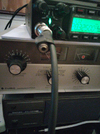Got my Quad6 up and running.
Nice radio and many useful programmable features. The upper bands are dead right now so can't get on the air with anyone yet.
I tested the audio against my other radios with a new $50 desk mic I wired up with an electret element and the audio sounds good. The stock mic sounds good too but it does have the hollow empty shell sound. Some foam stuffed in the mic case should take care of that.
The good:
Has many of the nice features you would want for both a 3 band Amateur radio and for CB users too. Many of them are set and forget in the setup menu while others will take some time to remember what and how to access them. Using A PC will be much easier but the supplied programming cable is too short, I need to get a 6 ft cable so I can keep it patched to my PC.
The TX frequency on LSB/USB is spot on when I did a zero beat to my Kenwood TS890 that I regularly check and zero beat to WWV, Nice!
For FM repeaters and other usage, this radio has a CTCSS/DCS Tones already integrated on the main board and I tested it with my Kenwood and it does work. The older model required you to install a separate modular board.
I like the choices and adjustments of noise reduction and filtering along with being able to turn off modes you won't or don't use (can only be done on PC though).
For those who insist on an unlocked clarifier, the menu gives the choice of TX, RX or both so no mod is necessary. Also has two select-able clarifier ranges.
The VOX and scanning features along with adjustable AGC is a nice touch too.
The not so good:
Being a small footprint radio, I found the coax connector was hard to tighten due to the lack of room between the heat sink and lower frame.
The 15 meter mod was easy but as I suspected, the power out was lower. Mine shows about 50 watts on SSB and a bit more on AM. Not critical, I do have an amp to compensate.
Under the hood I noticed there are NO pots for the golden screwdriver. This is actually a good thing. However all adjustments have to made in the service menu. It's already been mentioned you better write the values down first before you change anything because there is no default setting.
The power cable is long enough but the red and black wires are split. This makes it easy to get caught up in something or just get tangled. First thing I did was tape the wires together every few feet to avoid those problems.
There is only an external speaker jack on the back panel, no PA (who really uses that) or CW jack. To get these features you would have to go through the front mic jack with a break out cable. Not a big deal because I don't think too many user will be on CW or needing a PA with this radio.
There are a couple features I see that are only accessible by using a PC. For instance, setting the radio up to use as a 10 meter only or full coverage. Scott's radio shop already had this set for full coverage. I would think this feature should be menu accessible.
All in all this radio is truly light years ahead of the RCI 2950's and any other export radio to date. I would recommend this as an excellent choice for mobile or base station!
Nice radio and many useful programmable features. The upper bands are dead right now so can't get on the air with anyone yet.
I tested the audio against my other radios with a new $50 desk mic I wired up with an electret element and the audio sounds good. The stock mic sounds good too but it does have the hollow empty shell sound. Some foam stuffed in the mic case should take care of that.
The good:
Has many of the nice features you would want for both a 3 band Amateur radio and for CB users too. Many of them are set and forget in the setup menu while others will take some time to remember what and how to access them. Using A PC will be much easier but the supplied programming cable is too short, I need to get a 6 ft cable so I can keep it patched to my PC.
The TX frequency on LSB/USB is spot on when I did a zero beat to my Kenwood TS890 that I regularly check and zero beat to WWV, Nice!
For FM repeaters and other usage, this radio has a CTCSS/DCS Tones already integrated on the main board and I tested it with my Kenwood and it does work. The older model required you to install a separate modular board.
I like the choices and adjustments of noise reduction and filtering along with being able to turn off modes you won't or don't use (can only be done on PC though).
For those who insist on an unlocked clarifier, the menu gives the choice of TX, RX or both so no mod is necessary. Also has two select-able clarifier ranges.
The VOX and scanning features along with adjustable AGC is a nice touch too.
The not so good:
Being a small footprint radio, I found the coax connector was hard to tighten due to the lack of room between the heat sink and lower frame.
The 15 meter mod was easy but as I suspected, the power out was lower. Mine shows about 50 watts on SSB and a bit more on AM. Not critical, I do have an amp to compensate.
Under the hood I noticed there are NO pots for the golden screwdriver. This is actually a good thing. However all adjustments have to made in the service menu. It's already been mentioned you better write the values down first before you change anything because there is no default setting.
The power cable is long enough but the red and black wires are split. This makes it easy to get caught up in something or just get tangled. First thing I did was tape the wires together every few feet to avoid those problems.
There is only an external speaker jack on the back panel, no PA (who really uses that) or CW jack. To get these features you would have to go through the front mic jack with a break out cable. Not a big deal because I don't think too many user will be on CW or needing a PA with this radio.
There are a couple features I see that are only accessible by using a PC. For instance, setting the radio up to use as a 10 meter only or full coverage. Scott's radio shop already had this set for full coverage. I would think this feature should be menu accessible.
All in all this radio is truly light years ahead of the RCI 2950's and any other export radio to date. I would recommend this as an excellent choice for mobile or base station!





